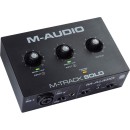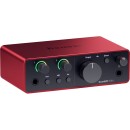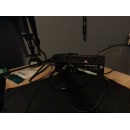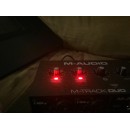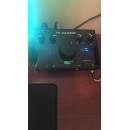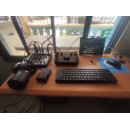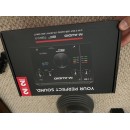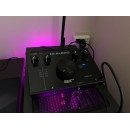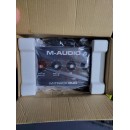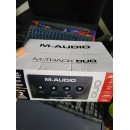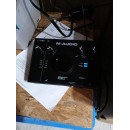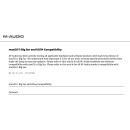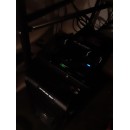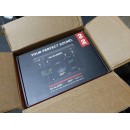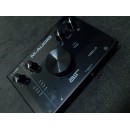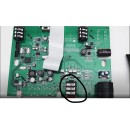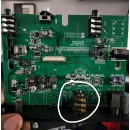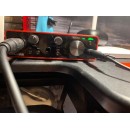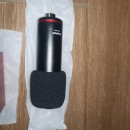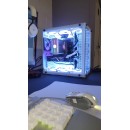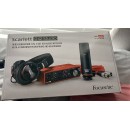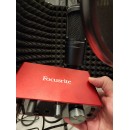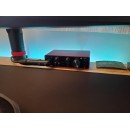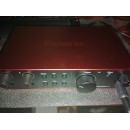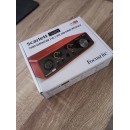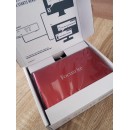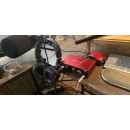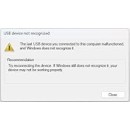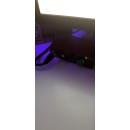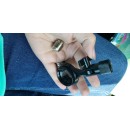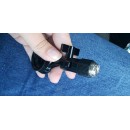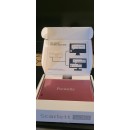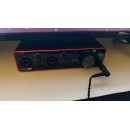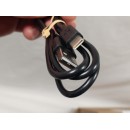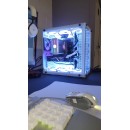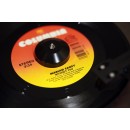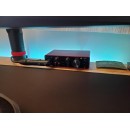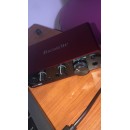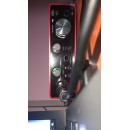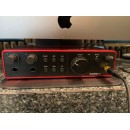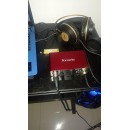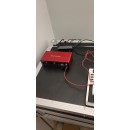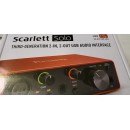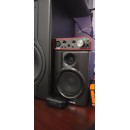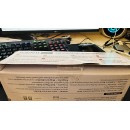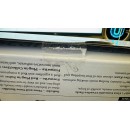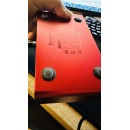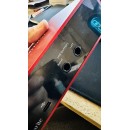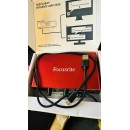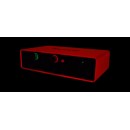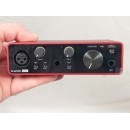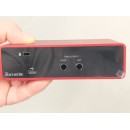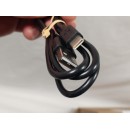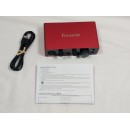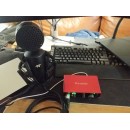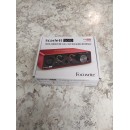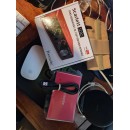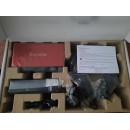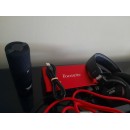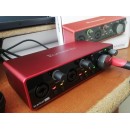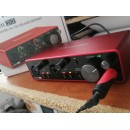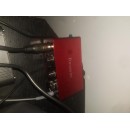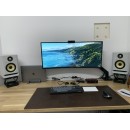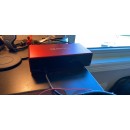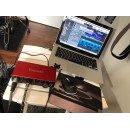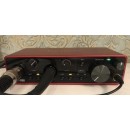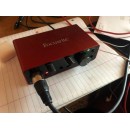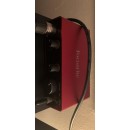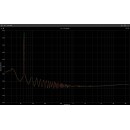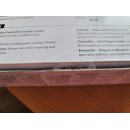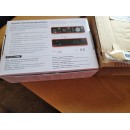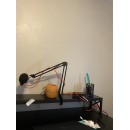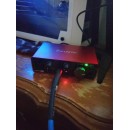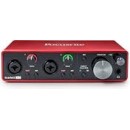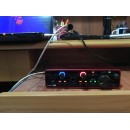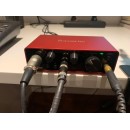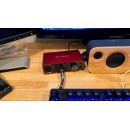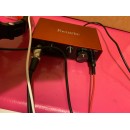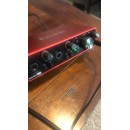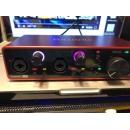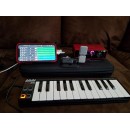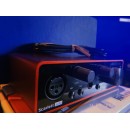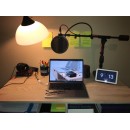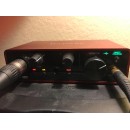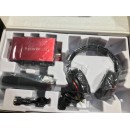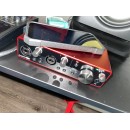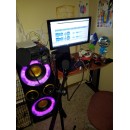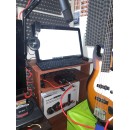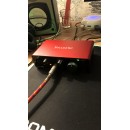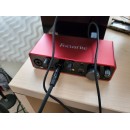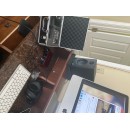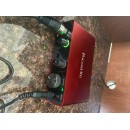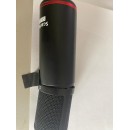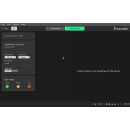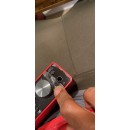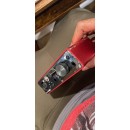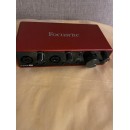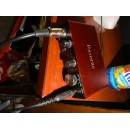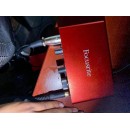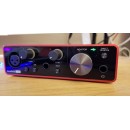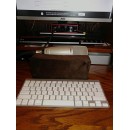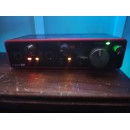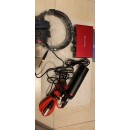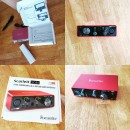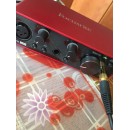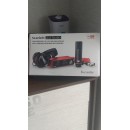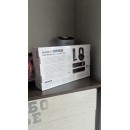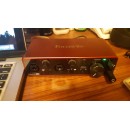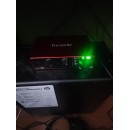M-Audio M-Track Solo vs Focusrite Scarlett Solo (4th Gen): Comprehensive Comparison
The Focusrite Scarlett Solo (4th Gen) is renowned for its high-quality preamps and professional-grade sound. It features a single upgraded Scarlett mic preamp with a switchable Air mode that emulates the rich, airy sound of Focusrite's original ISA preamps. This model includes a single XLR input for microphones and a line/instrument input, making it ideal for solo recording artists who need a straightforward, reliable interface. The Scarlett Solo supports up to 24-bit/192kHz resolution for pristine audio quality. The inclusion of a USB-C connection ensures fast and reliable data transfer, and it also boasts low-latency performance, which is crucial for real-time monitoring and recording. Additionally, the Scarlett Solo comes with a comprehensive software bundle, including Ableton Live Lite, Pro Tools First, and Focusrite’s Red Plug-in Suite, offering excellent value for beginners and professionals alike.
In contrast, the M-Audio M-Track Solo Desktop 2x2 USB Audio Interface is a more budget-friendly option, making it accessible for those just starting in audio recording or those needing a secondary interface. It features two channels with a single XLR/TRS combo input and a dedicated instrument input, allowing for more flexibility when recording multiple sources simultaneously. The M-Track Solo supports up to 16-bit/48kHz resolution, which is adequate for most entry-level recording needs but falls short of the high-definition capabilities of the Scarlett Solo. Despite its lower price point, the M-Track Solo includes a USB-A connection and offers direct monitoring with a simple switch to eliminate latency. It also comes with a software bundle that includes Pro Tools First M-Audio Edition and MPC Beats, providing users with essential tools to start producing music.
In summary, the Focusrite Scarlett Solo (4th Gen) is an excellent choice for those seeking superior audio quality, robust build, and comprehensive software support. Its single mic preamp with Air mode and higher resolution recording make it ideal for professional solo artists and podcasters. The M-Audio M-Track Solo, while more limited in terms of resolution and preamp quality, offers greater input flexibility and affordability, making it suitable for beginners and those on a tight budget. Both interfaces provide essential features for home recording, but your choice will depend on your specific needs and budget constraints.
In-Depth Specifications, Advantages, and Disadvantages
| User Rating Based on Analysis of Reviews | |
|---|---|
|
Show More |
| Pros: | |
|---|---|
|
|
| Cons: | |
|---|---|
|
|
| Key Specs | |
|---|---|
| Channels of I/O | |
| Analog: 2 Inputs / 2 Outputs |
Analog: 2 Inputs / 2 Outputs at 192 kHz |
| Maximum Sampling Rate | |
| 48 kHz / 16-Bit | 192 kHz / 24-Bit |
| Number of Microphone Inputs | |
| 1 Preamp | 1 |
| Analog Audio I/O | |
| 1x Combo XLR-1/4" TRS Balanced Mic/Line Input (Front Panel) 1x 1/4" TRS Balanced/Unbalanced Line/Hi-Z Input (Front Panel) 1x Stereo RCA Coaxial Unbalanced Monitor Output 1x 1/8" / 3.5 mm TRS Unbalanced Headphone Output (Front Panel) |
1x XLR 3-Pin Balanced Mic Input 1x 1/4" TS Unbalanced Line/Hi-Z Input (Front Panel) 2x 1/4" TRS Balanced Monitor Output 1x 1/4" TRS Headphone Output (Front Panel) |
| Host Connection | |
| 1x USB-B (Class-Compliant) | 1x USB-C |
| OS Compatibility | |
| macOS 10.8 or Later Windows 7 or Later (32-/64-Bit) |
macOS Windows |
| Power Requirements | |
| USB Bus Power | USB Bus Power, USB Power Adapter (Not Included) |
The Focusrite Scarlett Solo USB-C Audio Interface (4th Generation) offers superior audio quality with a maximum sampling rate of 192 kHz at 24-bit resolution, compared to the M-Audio M-Track Solo's 48 kHz at 16-bit resolution. This higher sampling rate and bit depth in the Scarlett Solo provide a more detailed and accurate representation of the audio signal, making it a better choice for professionals seeking high-fidelity sound.
In terms of analog audio I/O, both interfaces provide 2 inputs and 2 outputs. The Scarlett Solo includes 1x XLR 3-Pin Balanced Mic Input and 1x 1/4" TS Unbalanced Line/Hi-Z Input on the front panel, along with 2x 1/4" TRS Balanced Monitor Outputs and 1x 1/4" TRS Headphone Output. Conversely, the M-Audio M-Track Solo features a combo XLR-1/4" TRS Balanced Mic/Line Input and 1x 1/4" TRS Balanced/Unbalanced Line/Hi-Z Input on the front panel, with 1x Stereo RCA Coaxial Unbalanced Monitor Output and 1x 1/8" / 3.5 mm TRS Unbalanced Headphone Output. The Scarlett Solo's balanced outputs can provide better noise rejection, which is beneficial in professional settings.
Regarding connectivity, the Focusrite Scarlett Solo uses a USB-C host connection, which is more modern and versatile compared to the M-Audio M-Track Solo's USB-B connection. Both interfaces are compatible with macOS and Windows operating systems, but the Scarlett Solo’s support for USB-C can offer more reliable and faster data transfer, as well as broader compatibility with newer devices.
Both interfaces are USB bus-powered, making them equally convenient for mobile setups. However, the Scarlett Solo also supports an optional USB power adapter (not included), providing additional flexibility for power sources.
Overall, the Focusrite Scarlett Solo USB-C Audio Interface (4th Generation) stands out with its higher sampling rate, modern USB-C connection, and balanced outputs, making it a more robust choice for users requiring professional-grade audio quality and connectivity options. The M-Audio M-Track Solo, while offering adequate features for basic recording needs, is more limited in terms of audio resolution and connectivity.
| General | |
|---|---|
| Channels of I/O | |
| Analog: 2 Inputs / 2 Outputs |
Analog: 2 Inputs / 2 Outputs at 192 kHz |
| Maximum Sampling Rate | |
| 48 kHz / 16-Bit | 192 kHz / 24-Bit |
| Number of Microphone Inputs | |
| 1 Preamp | 1 |
| Built-In Microphone | |
| Input Level Adjustment | |
| 2x Knob | 2x Knob |
| Expansion Slots | |
The Focusrite Scarlett Solo provides 2 inputs and 2 outputs at a high maximum sampling rate of 192 kHz and 24-bit resolution. This high sampling rate allows for superior audio fidelity, making it well-suited for professional audio recording and production. It includes 1 microphone input, and the input levels can be adjusted via two dedicated knobs. This model does not have built-in DSP or expansion slots, but its high-quality audio performance and USB-C connectivity make it a robust option for musicians and producers looking for high-resolution audio capture.
In contrast, the M-Audio M-Track Solo Desktop 2x2 USB Audio Interface also offers 2 inputs and 2 outputs but at a lower maximum sampling rate of 48 kHz and 16-bit resolution. While this is sufficient for many basic recording needs, it does not match the high-resolution capabilities of the Focusrite Scarlett Solo. It includes 1 microphone preamp input and similarly features two knobs for input level adjustment. Like the Focusrite model, the M-Audio interface does not have built-in DSP or expansion slots. Its primary advantage is its affordability and simplicity, making it an accessible choice for beginners or those with less demanding audio requirements.
In summary, the Focusrite Scarlett Solo stands out with its higher sampling rate and 24-bit audio resolution, making it ideal for more detailed and professional audio work. The M-Audio M-Track Solo, with its lower sampling rate and 16-bit resolution, offers a more budget-friendly option for basic recording tasks. Both interfaces provide essential features like input level adjustment via knobs and lack built-in DSP or expansion slots, but they cater to different levels of audio fidelity and user needs.
| Signal Processing | |
|---|---|
| Gain/Trim Range | |
| Mic Inputs: 0 to +54 dB Line/Hi-Z Inputs: -10 to +44 dB |
Mic/Line Inputs: Up to +69 dB Hi-Z Inputs: 62 dB |
The Focusrite Scarlett Solo USB-C Audio Interface (4th Generation) boasts a notable gain/trim range, providing up to +69 dB for mic/line inputs and 62 dB for Hi-Z inputs. This wide range allows for capturing a variety of sound sources with clarity and precision. It is designed to accommodate both microphones and instruments with high fidelity, making it a versatile choice for musicians and audio engineers who require a robust and dynamic audio interface.
In contrast, the M-Audio M-Track Solo Desktop 2x2 USB Audio Interface offers a gain/trim range of 0 to +54 dB for mic inputs and -10 to +44 dB for line/Hi-Z inputs. While this range is more limited compared to the Focusrite Scarlett Solo, it still provides adequate amplification for home studio setups and basic recording needs. However, the M-Audio interface lacks additional features such as a pad, high-pass filter, and solo/mute functions, which may limit its flexibility and control in certain recording scenarios.
Overall, the Focusrite Scarlett Solo USB-C Audio Interface (4th Generation) stands out for its extensive gain/trim range and high-quality input capabilities, making it a more versatile and powerful option for users seeking professional-grade recordings. The M-Audio M-Track Solo, while offering essential functionalities for basic recording, does not include advanced features like a pad, high-pass filter, or solo/mute options, which may be a consideration for users requiring more control and versatility in their audio interface.
| Connectivity | |
|---|---|
| Analog Audio I/O | |
| 1x Combo XLR-1/4" TRS Balanced Mic/Line Input (Front Panel) 1x 1/4" TRS Balanced/Unbalanced Line/Hi-Z Input (Front Panel) 1x Stereo RCA Coaxial Unbalanced Monitor Output 1x 1/8" / 3.5 mm TRS Unbalanced Headphone Output (Front Panel) |
1x XLR 3-Pin Balanced Mic Input 1x 1/4" TS Unbalanced Line/Hi-Z Input (Front Panel) 2x 1/4" TRS Balanced Monitor Output 1x 1/4" TRS Headphone Output (Front Panel) |
| Phantom Power | |
| 48 V, Selectable On/Off | 48 V, Selectable On/Off |
| Digital Audio I/O | |
| Host Connection | |
| 1x USB-B (Class-Compliant) | 1x USB-C |
| Host Connection Protocol | |
| USB 2.0 | USB 2.0 |
| USB (Non-Host) | |
| Sync I/O | |
| Network I/O | |
| MIDI I/O | |
The Focusrite Scarlett Solo USB-C Audio Interface (4th Generation) comes with 1x XLR 3-Pin Balanced Mic Input and 1x 1/4" TS Unbalanced Line/Hi-Z Input on the front panel. For outputs, it includes 2x 1/4" TRS Balanced Monitor Outputs and 1x 1/4" TRS Headphone Output also on the front panel. The Scarlett Solo provides 48V phantom power, selectable on/off, making it suitable for condenser microphones. It connects to the host via a USB-C port using the USB 2.0 protocol. This model does not feature any digital audio I/O, sync I/O, network I/O, MIDI I/O, or wireless capabilities.
On the other hand, the M-Audio M-Track Solo Desktop 2x2 USB Audio Interface is equipped with 1x Combo XLR-1/4" TRS Balanced Mic/Line Input and 1x 1/4" TRS Balanced/Unbalanced Line/Hi-Z Input on the front panel. It offers 1x Stereo RCA Coaxial Unbalanced Monitor Output and 1x 1/8" / 3.5 mm TRS Unbalanced Headphone Output on the front panel. Similar to the Scarlett Solo, it also provides 48V phantom power, selectable on/off. The M-Track Solo connects to the host using a USB-B port (class-compliant) with the USB 2.0 protocol. This interface also lacks digital audio I/O, sync I/O, network I/O, MIDI I/O, and wireless functionalities.
In summary, while both interfaces offer similar connectivity options and phantom power, the Focusrite Scarlett Solo features balanced monitor outputs and a USB-C connection, which might appeal to users looking for potentially cleaner audio signals and modern connectivity. The M-Audio M-Track Solo provides a combo input and a more traditional USB-B connection, which could be preferable for users needing simpler integration with older systems or additional input flexibility.
| Performance | |
|---|---|
| Frequency Response | |
| Mic, Line, Hi-Z Inputs: 20 Hz to 20 kHz ±0.1 dB Monitor Outputs: 20 Hz to 20 kHz ±0.1 dB Headphone Outputs: 20 Hz to 20 kHz ±0.5 dB |
XLR Mic Inputs: 20 Hz to 20 kHz ±0.06 dB 1/4" Line Inputs: 20 Hz to 20 kHz 0.05 dB 1/4" Hi-Z Inputs: 20 Hz to 20 kHz 0.15 dB |
| Maximum Output Level | |
| Line Outputs: +4 dBu |
1/4" Line: +16 dBu |
| Headphone Output Power | |
| 60 mW per Channel into 32 Ohms |
1/4": 32 mW into 33 Ohms 22 mW into 300 Ohms |
| Impedance | |
| Hi-Z Inputs: 1 Megohm (Unbalanced) |
XLR Mic Inputs: 3 Kilohms 1/4" Line Inputs: 60 Kilohms 1/4" Hi-Z Inputs: 1 Megohms 1/4" Line Outputs: 200 Ohms 1/4" Headphone Outputs: < 50 Ohm |
| THD+N | |
| Mic Inputs: 0.003% (A-Weighted, Min Gain, at 0 dBu) Line Inputs: 0.002% (A-Weighted, Min Gain, at 0 dBu) Hi-Z Inputs: 0.005% (A-Weighted, Min Gain, at 0 dBu) Monitor Outputs: 0.002% (A-Weighted, at 0 dBu) Headphone Outputs: 0.02% (A-Weighted) |
XLR Mic Inputs: -100 dB (at Minimum Gain) 1/4" Line Inputs: -100 dB (at 8 dB Gain) 1/4" Hi-Z Inputs: -80 dB (at Minimum Gain) 1/4" Line Outputs: -100 dB (at Minimum Gain) 1/4" Headphone Outputs: -97 dB (at 33 Ohms) -102 dB (at 300 Ohms) Digital A/D Converters: -110 dB Digital D/A Converters: -115 dB |
| EIN | |
| Mic Inputs: -128 dBu A-Weighted (Max Gain) |
XLR Mic Inputs: -127 dBu A-Weighted |
The Focusrite Scarlett Solo offers a frequency response of 20 Hz to 20 kHz with variations of ±0.06 dB for XLR mic inputs, ±0.05 dB for 1/4" line inputs, and ±0.15 dB for 1/4" Hi-Z inputs. In comparison, the M-Audio M-Track Solo provides a slightly less precise frequency response of ±0.1 dB for mic, line, and Hi-Z inputs, and ±0.5 dB for headphone outputs. This indicates that the Scarlett Solo potentially offers slightly better accuracy in maintaining the integrity of the audio signal across its frequency range.
Regarding maximum input levels, the Scarlett Solo supports up to 9.5 dBu for XLR mic inputs, 22 dBu for 1/4" line inputs, and 12 dBu for 1/4" Hi-Z inputs. On the other hand, the M-Track Solo does not provide specific maximum input levels but does specify a maximum output level of +4 dBu for line outputs, which is lower than the Scarlett Solo's +16 dBu for 1/4" line outputs.
Headphone output power is another area of difference. The Focusrite Scarlett Solo delivers 32 mW into 33 Ohms and 22 mW into 300 Ohms, whereas the M-Audio M-Track Solo offers a higher output power of 60 mW per channel into 32 Ohms. This suggests that the M-Track Solo may provide a stronger headphone output, potentially beneficial for users requiring higher volume levels.
Impedance specifications reveal that the Scarlett Solo offers 3 Kilohms for XLR mic inputs, 60 Kilohms for 1/4" line inputs, and 1 Megohm for 1/4" Hi-Z inputs, with headphone outputs rated at less than 50 Ohms. The M-Track Solo specifies an impedance of 1 Megohm for Hi-Z inputs but does not detail other input impedances.
In terms of dynamic range, the Scarlett Solo excels with 113 dBA for XLR mic and 1/4" line inputs, 112 dBA for 1/4" Hi-Z inputs, and up to 130 dBA for digital D/A converters. The M-Track Solo reports 109 dB (A-Weighted) for mic inputs and monitor outputs, and 100 dB (A-Weighted) for headphone outputs, indicating that the Scarlett Solo has a superior dynamic range overall.
Total Harmonic Distortion plus Noise (THD+N) values for the Scarlett Solo are -100 dB for XLR mic and 1/4" line inputs, -80 dB for 1/4" Hi-Z inputs, and varying values for headphone outputs depending on impedance. The M-Track Solo presents THD+N values of 0.003% for mic inputs, 0.002% for line inputs, 0.005% for Hi-Z inputs, and 0.02% for headphone outputs, showing that both interfaces maintain low levels of distortion, though the Scarlett Solo offers slightly better performance in some areas.
Finally, Equivalent Input Noise (EIN) is -127 dBu A-Weighted for the Scarlett Solo's XLR mic inputs and -128 dBu A-Weighted for the M-Track Solo's mic inputs, indicating that both interfaces are quite similar in this regard, with the M-Track Solo having a marginally better EIN.
Overall, the Focusrite Scarlett Solo USB-C Audio Interface (4th Generation) tends to offer higher specifications in dynamic range, frequency response accuracy, and output levels, whereas the M-Audio M-Track Solo provides stronger headphone output power. Both interfaces have unique strengths that cater to different user needs.
| Digital Audio | |
|---|---|
| Sample Rates | |
| 48 kHz (AD/DA Conversion) | 44.1 / 48 / 88.2 / 96 / 176.4 / 192 kHz |
| Bit Depths | |
| 16-Bit (AD/DA Conversion) | 24-Bit |
| Sync Sources | |
| Internal | Internal |
The Focusrite Scarlett Solo USB-C Audio Interface (4th Generation) supports a wide range of sample rates, including 44.1, 48, 88.2, 96, 176.4, and 192 kHz, making it highly versatile for various recording scenarios, from standard to high-resolution audio projects. It operates at a 24-bit depth, which ensures high-quality audio recording and playback. The sync source for this interface is internal, providing stable and reliable synchronization during recording and playback sessions.
On the other hand, the M-Audio M-Track Solo Desktop 2x2 USB Audio Interface supports a single sample rate of 48 kHz for both analog-to-digital (AD) and digital-to-analog (DA) conversions. It does not offer sample rate conversion, which could limit its flexibility in different recording environments. The bit depth for the M-Audio M-Track Solo is 16-bit, which is adequate for basic recording tasks but may not capture the same level of detail and dynamic range as the 24-bit depth offered by the Focusrite Scarlett Solo. One notable feature of the M-Audio interface is its zero-latency direct monitoring, which allows users to hear their inputs in real-time without any noticeable delay. Like the Scarlett Solo, the M-Audio M-Track Solo also utilizes an internal sync source for stable performance.
In summary, the Focusrite Scarlett Solo USB-C Audio Interface (4th Generation) offers superior sample rate flexibility and higher bit depth, making it a better choice for users seeking high-fidelity recordings. The M-Audio M-Track Solo, while more limited in sample rate and bit depth, provides essential features like zero-latency monitoring, which is beneficial for real-time audio tracking and monitoring. Both interfaces use internal sync sources to ensure reliable operation.
| Audio Storage & Playback |
|---|
| Compatibility | |
|---|---|
| OS Compatibility | |
| macOS 10.8 or Later Windows 7 or Later (32-/64-Bit) |
macOS Windows |
The Focusrite Scarlett Solo (4th Generation) is OS compatible with both macOS and Windows, and is also mobile app compatible, specifically with iPadOS. This makes it a versatile choice for users who might want to utilize their iPad for mobile recording sessions. The USB-C connectivity ensures fast and reliable data transfer, which is beneficial for latency-sensitive applications such as live monitoring and recording.
On the other hand, the M-Audio M-Track Solo Desktop 2x2 USB Audio Interface supports macOS 10.8 or later and Windows 7 or later (32-/64-bit). It requires an available USB-A port and comes with a USB cable included in the package. Additionally, the M-Audio interface necessitates an internet connection for registration and software/driver downloads, which is an extra step users need to consider for initial setup and updates.
In summary, while both interfaces offer cross-platform compatibility with macOS and Windows, the Focusrite Scarlett Solo extends its functionality to iPadOS, making it more versatile for mobile recording. The M-Audio M-Track Solo, meanwhile, requires an internet connection for setup and is designed for use with a USB-A port, which may be a consideration depending on the user's available hardware and connectivity preferences.
| Power | |
|---|---|
| Power Requirements | |
| USB Bus Power | USB Bus Power, USB Power Adapter (Not Included) |
The Focusrite Scarlett Solo USB-C Audio Interface (4th Generation) can be powered through USB bus power or an optional USB power adapter. It also supports an AC/DC power adapter with a requirement of 5 VDC at 900 mA. The power consumption for this interface is specified at 4.5 W, indicating a relatively modest power draw for its operational needs.
In contrast, the M-Audio M-Track Solo Desktop 2x2 USB Audio Interface has a simpler power requirement, relying solely on USB bus power. This streamlined power solution makes it potentially more convenient for users who prefer not having to deal with additional power adapters or specific voltage requirements.
In summary, the Focusrite Scarlett Solo offers flexibility in power options with support for USB bus power, a USB power adapter, and an AC/DC power adapter. It has a specific power consumption rate of 4.5 W. On the other hand, the M-Audio M-Track Solo maintains a straightforward approach with its exclusive reliance on USB bus power.
| Physical | |
|---|---|
| Dimensions | |
| 6.4 x 4.5 x 2.1" / 16.3 x 11.4 x 5.3 cm | 5.63 x 3.78 x 1.79" / 14.3 x 9.6 x 4.55 cm |
| Weight | |
| 0.7 lb / 0.3 kg | 0.8 lb / 363.0 g |
The Focusrite Scarlett Solo USB-C Audio Interface (4th Generation) has dimensions of 5.63 x 3.78 x 1.79 inches (14.3 x 9.6 x 4.55 cm), making it relatively compact. It weighs 0.8 lb (363.0 g), which contributes to its portability and ease of use, especially in mobile recording setups or small studios.
On the other hand, the M-Audio M-Track Solo Desktop 2x2 USB Audio Interface is slightly larger, with dimensions of 6.4 x 4.5 x 2.1 inches (16.3 x 11.4 x 5.3 cm). Despite its larger size, it is marginally lighter, weighing 0.7 lb (0.3 kg). This makes it a good option for users who might prioritize a bit more surface area for control knobs and inputs without significantly increasing the weight.
In summary, the Focusrite Scarlett Solo is more compact and slightly heavier, which could appeal to users looking for a smaller footprint and robust build. Conversely, the M-Audio M-Track Solo offers a larger surface area while keeping the weight lower, which might be preferable for users who want more space for interface controls without adding much to their gear's weight.
| Packaging Info | |
|---|---|
| Package Weight | |
| 1.155 lb | 1.305 lb |
| Box Dimensions (LxWxH) | |
| 8 x 6 x 3.7" | 7.2 x 6.1 x 2.5" |
Starting with the Focusrite Scarlett Solo (4th Generation), it has a package weight of 1.305 lb, making it slightly heavier than the M-Audio M-Track Solo, which weighs 1.155 lb. This difference in weight might be minor, but it could be a consideration for users who prioritize portability and ease of transportation.
In terms of dimensions, the Focusrite Scarlett Solo measures 7.2 x 6.1 x 2.5 inches. In contrast, the M-Audio M-Track Solo is slightly larger with box dimensions of 8 x 6 x 3.7 inches. The larger size of the M-Audio M-Track Solo may suggest a more robust build or additional features, but it also means it will take up more space on a desktop or in a bag.
Both audio interfaces are designed to be compact and user-friendly, but the Focusrite Scarlett Solo's slightly smaller and lighter build might appeal more to users with limited studio space or those who need a more portable solution. On the other hand, the M-Audio M-Track Solo's larger size might be indicative of a potentially more durable design or additional connectivity options.
In summary, the Focusrite Scarlett Solo (4th Generation) is slightly lighter and more compact compared to the M-Audio M-Track Solo. These differences in weight and dimensions could influence a user’s decision based on their specific needs for portability and space management in their recording setup.
| Customer Images | |
|---|---|
| Videos | |
|---|---|
|
|
|
